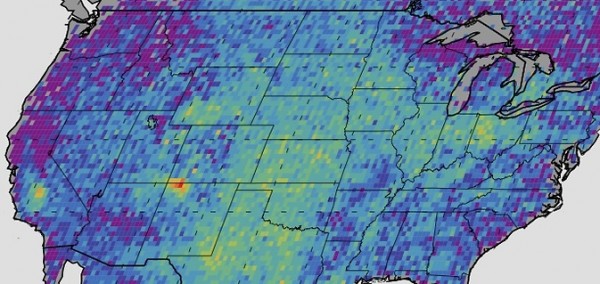Scientists to Unravel Dangerous Methane Hotspot at Four Corners
| Ana Verayo | | Apr 12, 2015 07:16 AM EDT |
(Photo : NASA/JPL-Caltech/University of Michigan) The Four Corners area (red) is the major U.S. hotspot for methane emissions in this map. Dark colors are lower than average; lighter colors are higher.
A methane hotspot detected over at Four Corners region located in Colorado, Utah, Arizona and New Mexico in southwest U.S. has remained a mystery after it was first spotted by a European Space Agency satellite.
Groups already starting their investigations regarding this bizarre atmospheric feature include the New Mexico Environment Department. The group will now host a forum on April 17 to further discuss the consequences to the environment of obtaining fossil fuel via fracking, a controversial practice.
Like Us on Facebook
According to Richard Goodyear from the New Mexico Environment Department, new data is now emerging from the detection of increasing levels of methane in the region and the department will now closely monitor this problem.
Now, a group of scientists have gathered at the Four Corners where the four states of Arizona, Colorado, Utah and New Mexico meet. The team is now examining the air and ground conditions to better understand the methane source is and what risks and dangers it might expose to the environment and humans.
There is now an opportunity to investigate further and ultimately solve the Four Corners mystery with the help of different groups and their ground based and airborne resources, according to Christian Frankenberg from NASA's Jet Propulsion Laboratory.
A prior study in October 2014 revealed methane levels found in the Four Corners region is the highest in any location around the world. The hotspot originated from greenhouse gases that were present from 2003 to 2009, according to the researchers of this 2014 study.
NASA officials believe this anomaly is caused by high concentrations of methane due to fracking. Fracking involves pumping water, sand and chemicals into dry wells underground at extremely high velocities to destroy rock layers and release natural gases underneath that are mostly methane. Previous studies have already proven that greenhouse gases are released during fracking.
To investigate this methane hotspot, a pair of Twin Otter aircraft under NASA's JPL will fly over the region to monitor this hotspot. The planes will be equipped with instruments called the Next-Generation Airborne Visible/Infrared Imaging Spectrometer to measure its gas extent and the Hyperspectral Thermal Emission Spectrometer to pinpoint the source.
TagsScientists Unravel Mysterious Methane Hotspot Over at Four Corners, Greenhouse gases, four corners, US, methane hotspot four corners, NASA JPL
©2015 Chinatopix All rights reserved. Do not reproduce without permission
EDITOR'S PICKS
-

Did the Trump administration just announce plans for a trade war with ‘hostile’ China and Russia?
-

US Senate passes Taiwan travel bill slammed by China
-

As Yan Sihong’s family grieves, here are other Chinese students who went missing abroad. Some have never been found
-

Beijing blasts Western critics who ‘smear China’ with the term sharp power
-

China Envoy Seeks to Defuse Tensions With U.S. as a Trade War Brews
-

Singapore's Deputy PM Provides Bitcoin Vote of Confidence Amid China's Blanket Bans
-

China warns investors over risks in overseas virtual currency trading
-

Chinese government most trustworthy: survey
-

Kashima Antlers On Course For Back-To-Back Titles
MOST POPULAR
LATEST NEWS
Zhou Yongkang: China's Former Security Chief Sentenced to Life in Prison

China's former Chief of the Ministry of Public Security, Zhou Yongkang, has been given a life sentence after he was found guilty of abusing his office, bribery and deliberately ... Full Article
TRENDING STORY

China Pork Prices Expected to Stabilize As The Supplies Recover

Elephone P9000 Smartphone is now on Sale on Amazon India

There's a Big Chance Cliffhangers Won't Still Be Resolved When Grey's Anatomy Season 13 Returns

Supreme Court Ruled on Samsung vs Apple Dispute for Patent Infringement

Microsoft Surface Pro 5 Rumors and Release Date: What is the Latest?










